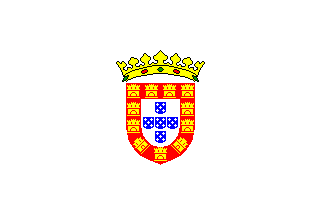
image by António Martins

Last modified: 2014-07-05 by klaus-michael schneider
Keywords: portugal: historical | kingdom of portugal | reino de portugal | royal standard |
Links: FOTW homepage |
search |
disclaimer and copyright |
write us |
mirrors
The crown appeared first on the coat of arms; when it appeared on the flags is not possible to say with great precision. In my rendition of the 1485-1495 royal standard the crown doesn’t appear. D. Manuel I (1495-1521) used the crowned shield over the cross of the Order of Christ (on the royal standard; he also owned a personal standard: diagonally quartered in red and white with the golden armillary sphere over all.)
Mario Fabretto, 25 May 1997
Usually depicted as a rectangular white field — with these
arms of its center. This was the first non-armorial flag used by a
portuguese monarch.
António Martins, 16 Apr 2000
Recently, as I become more and more awere of vex details, I noticed that not-so-carefull depictions of the portuguese coa had the bezants arranged in cross rather than saltire. This is quite a common error, but yesterday I found that particular arrangement in a statue depicting the "Angel of Portugal", at the Christ Covent, in Tomar, Portugal. This angel, a 16th ct. wood sculpture, bears a large pointed shield with the usual charges. The border, as usual at the time, had the number of castles that best suited its shape and size (!), this time 12 of them, and the eschuteons were very pointy and "unround", almost pentagonal — and on each of them, five bezants arranged in cross!
I’m sending this particular design in a (square) flag format to you — the source is authoritative enough to speculate that such a flag could have existed. Meanwhile I resoned that the saltire of five bezants (2+1+2), as opposed to the cross (1+3+1), is the best way to store five pieces in a near flat bottom space, while the cross is ideal to fit in a pointy bottom:
_______ _______
| o o | | o |
| o | | o o o |
| o o | \ o /
\_____/ \_/
Anything below this line was not added by the editor of this page.